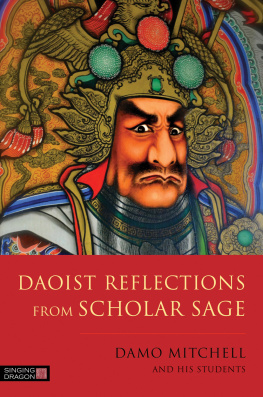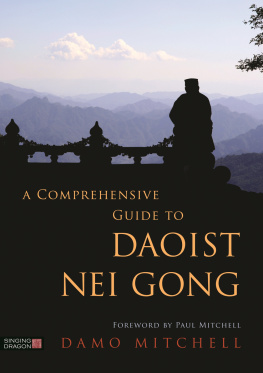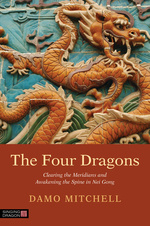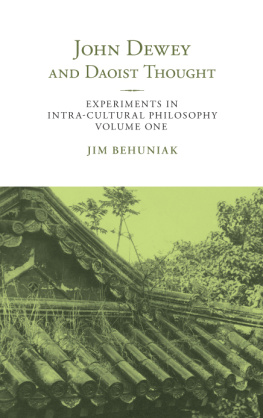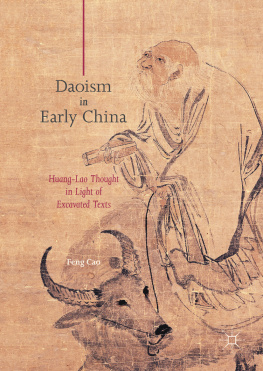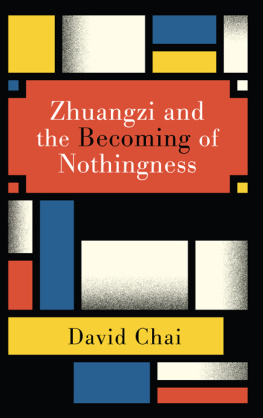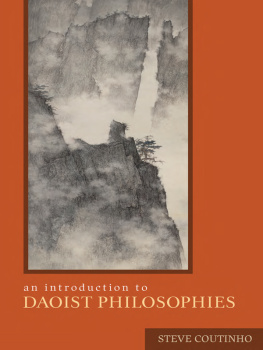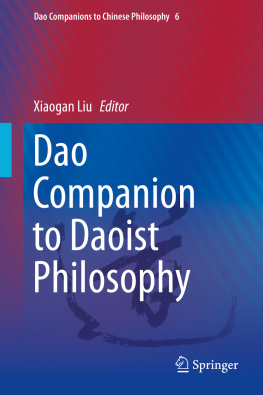
DAOIST REFLECTIONS
FROM SCHOLAR SAGE
Damo Mitchell and his students

LONDON AND PHILADELPHIA
CONTENTS
PREFACE
A n important aspect of any traditional study is exploration of the underlying theory. For many practitioners of Daoism this can seem like a strange statement; this is because it is generally seen as a purely doing tradition. Whilst it is true that all aspects of the practice must be directly experienced, this should always be supported by the foundation of our cognitive understanding. In this way our intellectual mind and our body-consciousness can come together to lead us along the path of Daoism. This was the original reason why I began to write.
In the beginning I was simply writing for myself, a way of structuring my thoughts. As I wrote it helped me to crystallise my understanding of Daoism. This continued for some time until I naturally moved into writing more publicly. Initially this writing was in the form of several books, but alongside this the idea for the Scholar Sage online magazine was born. This was a platform for me to write about various aspects of Daoism; sometimes technical aspects and sometimes purely theoretical. As much as anything it was a way for me to continue writing without being caught up in lengthy explorations of a single topic as is generally the case when you are writing a book. With the Scholar Sage project I could jump about from subject to subject as well as fill in the blanks with regards to small pieces of information that just had no obvious place within a larger text.
The website quickly proved popular and started to grow. On top of this it started to attract more writers from within the school and I was pleasantly surprised by two things: first, there were a number of people willing and able to write for the public and, second, they really knew their subject! I would like to be able to take credit for their knowledge due to me being their primary teacher, but actually I am pretty sure that they are so knowledgeable about the internal arts because they are highly motivated people who train diligently and then support this practice with theoretical study.
The site continues to grow and now includes a video section as well. It is exciting to see the positive feedback we get from readers who are happy to have a free source of information. Compared with many other Eastern traditions, Daoism is still relatively hard to find many writings on beyond almost incomprehensible translations of classics, which are only really for those deep in the more advanced aspects of the tradition.
The only real negative feedback we have received with regards to Scholar Sage is that many people do not like reading articles on the screen of their computer. Time and again people have asked us to produce a hard copy of the articles that they can hold in their hands, and so here it is: the Scholar Sage book!
What I have done is go through the site and select the most popular articles from the last couple of years and put them into this book. The majority of the articles are by me, but there are also articles written by other teachers in our school as well as senior students. It is always an amazing thing to sit and read articles by other teachers and students in the school. The level of effort and passion they have put into their practice shines out from their writings, as does the skill level they demonstrate in their chosen arts. I wish I could have selected more articles from the site as many of them were excellent, but if I did this the book would end up the size of a phone directory! Instead I selected some of my favourite articles as well as those I feel give a good spread of information on the topic of Daoism. Thank you so much to the other writers in the school who were happy to have their work contributed to this book.
Please note that the nature of the book means there is a variety of articles covering different subjects. I primarily tried to select articles on Nei Gong and alchemy, since this is what most people will have encountered in my previous writings, but there are also a couple of articles on martial arts and some relevant to Chinese medicine as well. In order to try and smooth out any continuity issues in the book I have gone back and re-edited the articles somewhat. This has been to minimise any repeated information in the book. As I edited the articles I also found that I felt the need to add sections to them, so you will also notice that several of the articles are longer and more in depth than the version you may have read online at the Scholar Sage website.
On top of this there are a few articles in here that never appeared on the site.
I hope that this book provides some new information for readers, as well as sometimes being thought provoking and, who knows, maybe even entertaining! The Scholar Sage website is stacked full of all sorts of esoteric guidance and I feel that this book is a reflection of the site. Consequently, there is a whole jumble of instructions and information to dive into. I hope you enjoy it.
Damo Mitchell, Vilamoura, Portugal
NOTES ON THE TEXT
Throughout this book we have used the Pinyin system of Romanisation for the majority of Chinese words. Please note that much of the theory in this book differs greatly from Western science. The classical Chinese approach to understanding the organs of the body, for example, is based around the function of their energetic system rather than their physical anatomy. To distinguish the two understandings from each other we have used capitalisation to indicate the Chinese understanding of the term. Heart refers to the classical Chinese understanding of the organ, whilst heart refers to the physical organ as understood within contemporary Western biological sciences.
As well as this we have had a lot of correspondence from native Chinese speakers who have been reading our books. This, combined with an increase in Chinese students, means that it is wise for us to put the Chinese characters next to each Pinyin term that we use within our writing. In order to not overcrowd the text we have included the Chinese character the first time each Pinyin term is used. The only exception to this is if it seems relevant to include the Chinese character on another occasion such as when listing Pinyin terms. As well as this, there is a full glossary of Chinese terminology at the rear of this book.
Also note that this book has contributions from a number of different authors. Though all of these writers are members of the same school, it is inevitable that they will each have their own take on the subject material. This means that there may occasionally be contradictions between different writers as each has their own opinion. Rather than detracting from the book, we feel that it makes the book more interesting! Also we have tried to edit the writings a little to make sure that the same terminology is used throughout; that being said, there may be some slight differences in the way that the terminology is used from person to person.
THE DING AND THE LU
Damo Mitchell
T he Ding ( ) and the Lu ( ) are two important regions of the energy body utilised within Daoist alchemical meditation. The Ding is the cauldron, whilst the Lu is the furnace or fire of cultivation. When working with these aspects of our inner universe it is crucial that we develop an understanding of their location, their function and the process of awakening them. If we look at the various arts and practices that have come out of the Daoist tradition we can see that each has its own terminology and unique ways of working. Understanding the nature of the Ding and the Lu is important to alchemical meditation, whereas they are rarely discussed within less intricate practices such as Qi Gong ( ) .
Next page
